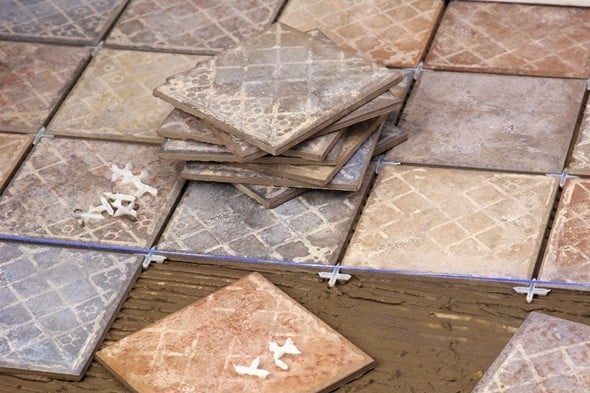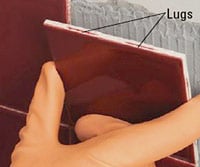When laying tile, whether on a floor or on the wall, there are only a few rules for how thick the grout lines have to be. In many cases it can be more of a design choice than a requirement. That being said, there are a few important facts and some guidelines you should know when trying to decide how thick your grout lines should be.
Tile Spacing Guide
Floor Tile Grout Lines
As a general rule, floor tiles should have grout lines of 1/8 inch or larger, depending on the type and size of tile. Special types, such as slate or quarry tiles, often do not have edges uniform enough to work with tight spacing. These tiles usually are spaced with grout lines 3/16 inch or wider.
Plastic spacers are usually used at tile corners to form even grout spaces. Some really large-format tiles, 18 by 18 inches square or larger, look good with very narrow grout lines that are filled with a grout colored to match the tile. This technique produces a floor that looks like a single slab.

Grout Lines for Wall Tiles
Small tiles, such as the 4-inch by 4-inch style commonly used on bathroom and kitchen walls, often are self-spacing. They have small protrusions called lugs that fit against adjoining tiles and create an automatic space for grout, normally 1/32 to 1/16 inch wide. Grout lines on walls usually do not exceed 1/16 inch because the tiles need to be stacked to help support them during installation.

Choosing a Grout Width
Small Grout Joints
In some cases you may have seen floors or walls where the tiles are laid so close to each other that it almost looks like there are no grout lines. The only way to achieve this look is to use what they call rectified tiles. The average tile is a natural product and is almost never exactly the same shape and size throughout (hence the need for grout lines). Rectified tiles are evenly cut and uniform on all sides. A small grout line width, about 1/16 inch, is possible with a rectified tile. Installing rectified tile flooring with small grout lines decreases maintenance requirements and looks great; however, it may be more difficult to achieve as there is little “wiggle room” during installation. Unsanded grout is recommended for small joints up to 1/8 inch wide.
Medium Grout Joints
Medium-sized grout line widths — 1/8 to 1/4 inch — require the use of sanded grout and are typically featured when moderate size variation occurs among the tiles or when tiles with lugs are used. Because a medium size grout line is easier to work with, and in most cases can hide some slight imperfections, it is often the choice of both experts and the average DIY homeowner.
Large Grout Joints
Tiles that vary in size and shape need large grout joint widths — 3/8 to 1/2 inch. Large grout joints will require the use of sanded grout. Marble flooring installed in different-sized, repeating patterns, such as the Versailles pattern, require large grout line widths.
Grout Joint Size for Imperfect Tiles
Grout joint size is about providing space for movement, but it is also about covering any imperfections. As stated above, a wider grout joint (3/16) is ideal for handmade tiles. Natural stone and other materials that don’t have a uniform measurement from one tile to the next also benefit from the wider grout joint.
The more the discrepancy between tile measurements, the wider your grout joint will need to be to accommodate the differences.
Location of Installation
Where the tile is being installed can also have an impact on grout joint width. A wider grout line can add traction in areas where tile might be wet and slippery like the kitchen, bathroom, or outdoors.
Tile installed on angles surfaces (ramps, shower floors, etc.) require more traction and a wider grout joint.
There are natural differences in grout joint width around corners or around curves. Going into a corner or curve, the grout joint will be more narrow and on the outside of corners and curves the joint will be wider.
As long as you follow the manufacturer recommendations, your grout joints can be both a statement of style and functional.
For more DIY tips and tricks, visit our blog.








Simply want to say your article is as astounding. The clearness on your publish is simply spectacular and that i can suppose you’re a professional on this subject. Well with your permission allow me to clutch your feed to keep up to date with coming near near post. Thanks a million and please continue the rewarding work.|
When I initially commented I clicked the “Notify me when new comments are added” checkbox and now each time a comment is added I get four e-mails with the same comment. Is there any way you can remove me from that service? Cheers!|
We’ll check on that issue. In the meantime, change your preferences from one of those emails to stop getting notifications.
Good blog post. I definitely love this site. Keep writing!|